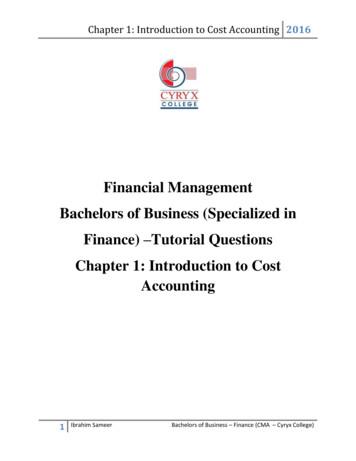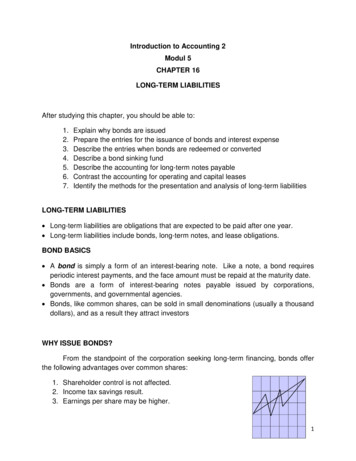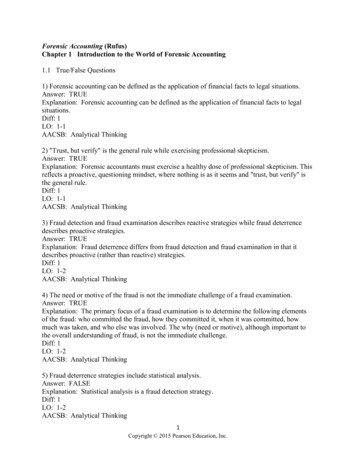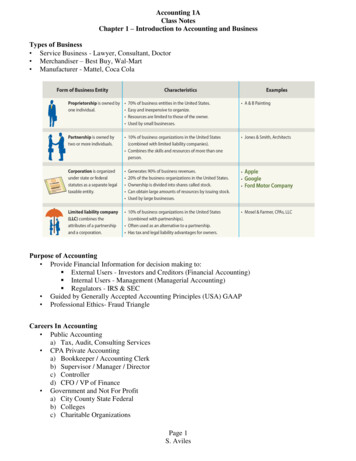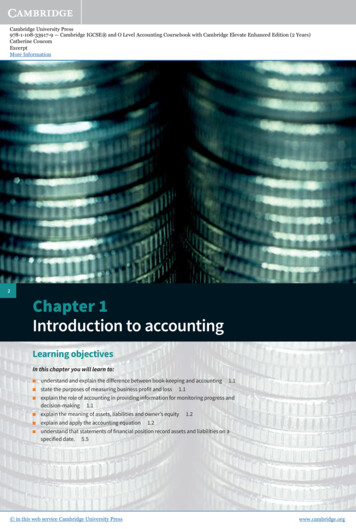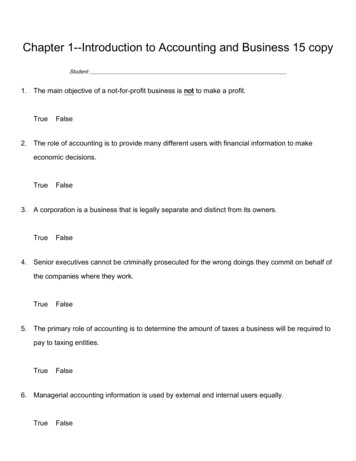
Transcription
1 Introduction to Accounting and BusinessChapter 1Introduction to Accounting and BusinessLearning Objective 1 Describe the nature of a business, the role of accounting,and ethics in business.Nature of Business and Accounting A business is an organization in which basic resources (inputs), such as materialsand labor, are assembled and processed to provide goods or services (outputs) tocustomers.basic resources(inputs), such asmaterials and laborassembled andprocessedgoods or services(outputs) tocustomers The objective of most businesses is to earn a profit. Profit is the difference between the amounts received from customers for goodsor services and the amounts paid for the inputs used to provide the goods orservices.Type of Business:Service Business Provide services rather than products to customers.Merchandising Business Sell products they purchase from other business tocustomers.Manufacturing Business Change basic input into products that are sold tocustomers.The Role of Accounting in BusinessThere is more than definitionAccounting is the art of recording, summarizing, classifying and reporting financialtransactions and other events of an enterprise.Accounting can be defined as an information system that provides reports to users aboutthe economic activities and condition of a business.T. Nora Aldawood
2 Introduction to Accounting and BusinessThe process by which accounting provides information to users :Identify UsersPrepareAccountingReportsRecordeconmic dataAsses UsersInformation'sNeedsDesignAccountingSystemT. Nora Aldawood
3 Introduction to Accounting and BusinessUsers of accounting can be divided into two groups: Internal Users External UsersUsers of rsGovernmentInvestorsFinancial AccountingT. Nora Aldawood
3 Introduction to Accounting and BusinessForm of Business EntityManagerial Accounting The area of accounting that provides internal users withinformation.Financial Accounting The area of accounting that provides external users withinformation. The objective of financial accounting is to provide relevant and timely informationfor the decision-making needs of users outside of the business. General-purpose financial statements are one type of financial accounting reportthat is distributed to external users.Learning Objective 2 Summarize the development of accounting principles andrelate them to practice.Generally Accepted Accounting Principles Financial accountants follow generally accepted accounting principles (GAAP) inpreparing reports. Within the U.S. , the Financial Accounting Standards Board (FASB) has the primaryresponsibility for developing accounting principles . Many countries ( including Saudi Arabia ) adopted the International FinancialReporting Standards (IFRS) that are issued by the International AccountingStandards Boards (IASB) . Within Saudi Arabia ,the Saudi Organisation for certified public accountant(SOCPA) has the primary responsibility for developing accounting principles. These reports allow investors and other users to compare one company to another .T. Nora Aldawood
4 Introduction to Accounting and BusinessProprietorshipIs owned by one individual (Small Businesses)PartnershipIs owned by two or more individualsCorporationIs owned by shareholders or stockholders (Large Firms)Some of Accounting Concepts GAAPBusiness EntityConcept The activities of a business are recorded separately from theactivities of its owners, creditors, or other.The Cost Concept Amounts are initially recorded in the accounting records at theircost or purchase price.The ObjectivityConcept Requires that the amounts recorded in the accounting records bebased on objective evidence.The Unit OfMeasure Concept Requires that economic data be recorded in dollars or riyals.The AccountingPeriod Concept Requires that revenues and expenses be reported in the properperiod. Supporting the reporting of revenues when they are earnedThe RevenueRecognition Concept regardless of when cash is received.The MatchingConcept Supporting reporting revenues and related expenses in the sameperiod.Learning Objective 3 State the accounting equation and define each element ofthe equation.The Accounting Equation The resources owned by a business are its assets.The rights of creditors are the debts of the business and are called liabilities.The rights of the owners are called owner’s equity.The equation Assets Liabilities Owner’s Equity is called the accountingequation.T. Nora Aldawood
5 Introduction to Accounting and BusinessAssets Liabilities Owner’s EquityAssets Liabilities Capital – Drawings Revenues - ExpensesDrawings Expenses Assets Liabilities Capital RevenuesDebit AccountsIf Debit, and if CreditCredit AccountsIf Credit, and if DebitElements of Accounting Equation :* All business transactions can be stated in terms of changes in the elements of theaccounting equation .ASSETS Resources owned by the businessType off AssetsFixed Assets Land, Buildings, Furniture, Cars, Machinery and Equipment.Current Assets Cash, Marketable Securities, Accounts Receivable, Notes receivables,Merchandise Inventory, Supplies, Prepaid Expenses, and Accrued Revenues.Intangible Assets Goodwill, Copy Right, Patent, Trade Mark.LIABILITIES The rights of creditorsType of LiabilitiesLong-Term Liabilities Bonds and Long-Term Loans.Short-Term Liabilities Accounts Payable, Notes Payable, Short-Term Loans, AccruedExpenses, and Unearned Revenues.OWNER’S EQUITY the rights of the ownersCapital and Net Income (Revenues – Expenses)T. Nora Aldawood
6 Introduction to Accounting and BusinessLearning Objective 4 Describe and illustrate how business transactions can berecorded in terms of the resulting change in the elements of the accountingequation.Business Transaction is an economic event or condition that directly changes anentity’s financial condition or its results of operations.Account payable is liability created by a purchase on account.Account receivable is a claim against a customer, which is an asset.Expenses Assets used in this process of earning revenue.Revenue the Amount of money that A business earned by selling goods or services toits customers.Examples of revenue Fees earned Revenue from providing services. Sales Revenue from the sale of merchandiseRent revenueInterest revenue.Some Notes before solving the transactions Account payable creditor suppliers purchase on account Account receivable customer client billed on account Revenues in services business called Fees earned but in merchandising businesscalled sales Revenues always credit account and the debit account can be cash, accountreceivables, or note receivables Expenses always debit account and the credit account is cash, accountpayable, or note payableT. Nora Aldawood
7 Introduction to Accounting and BusinessOn November 1, 2011, Chris Clark begins a business that will be known as Net Solution:TransactionA: On November 1, 2011, Chris Clark deposited 25,000 in a bank account in the name ofNet Solutions.(Assets (cash) Owner equity (capital))B: On November 5, 2011, Net Solutions paid 20,000 for the purchase of land as afuture building site.(Assets (cash) Assets (Land))C: On November 10, 2011, Net Solutions purchased supplies for 1,350 and agreed to paythe supplier in the near future.(Assets (supplies) Liabilities (Account Payable))D: On November 18, 2011, Net Solutions received cash of 7,500 for providing servicesto customers.(Assets (cash) Owner equity (Fees earned))E: On November 30, 2011, Net Solutions paid the following expenses: wages, 2,125; rent, 800; utilities, 450; and miscellaneous, 275.(Assets (cash) Owner equity (Expenses)) F: On November 30, 2011, Net Solutions paid creditors on account, 950.(Assets (cash) Liabilities (Account payable)) G: On November 30, 2011, Chris Clark determined that the cost of supplies on hand atthe end of the period was 550.(Assets (supplies) Owner equity (supp. Exp.))H: On November 30, 2011, Chris Clark withdrew 2,000 from Net Solutions for personaluse.(Assets (cash) Owner equity (Drawing))Instructions: Indicate the effect of each transaction using the following tabularheadings:T. Nora Aldawood
8 Introduction to Accounting and BusinessTransitionsAssetsCash Liabilities Supplies Land a. 25,000 b. -20,000 20,000 1,350c. Chris - ChrisAccounts Fees - Wages - Rent - Supplies - Utilities - Misc.Clark ClarkPayableEarned Exp.Exp.Exp.Exp.Exp.Capital Drawing 25,000 1,350 d. 7,500 e.-3,650 f.-950 -800g.h.-2,0005,900 55026,450-950 400 7,500-2,125-800-450-275 20,000 Owner Equity-800-2,000 25,000 – 2,000 7,500 – 2,125 - 800– 800– 450- 27526,450T. Nora Aldawood
9 Introduction to Accounting and BusinessLearning Objective 5 Describe the financial statements of a proprietorship and explainhow they interrelate.Financial Statements After transactions have been recorded and summarized, reports areprepared for users. The accounting reports providing this information are called t1IncomeA summary of the revenue and expenses for a specific periodStatementof time, such as a month or a year.StatementA summary of the changes in the owner's equity that haveof Owner'soccurred during a specific period of time, such as a month or aEquityyear.BalanceA list of the assets, liabilities, and owner's equity as of aSheetspecific date, usually at the close of the last day of a month or23Description of Statementsa year.4StatementA summary of cash receipts and cash payments for a specificof Cashperiod of time, such as a month or a year.flows* matching concept :This concept is applied by matching the expenses incureed during a period with the revenuethat those expenses incurred during aperiod with the revenue that those expenses generated.The excess of the revenue over the expenses is called net income , net profit or earningsIf the expenses exceed the revenue , the excess is a net loss .T. Nora Aldawood
10 Introduction to Accounting and BusinessIllustrative Problem – Page 25 & 26PE 1-2A – Page 29EX 1-6 - Page 33EX 1-8 & EX 1-9 – page 34PR 1-1A – page 39T. Nora Aldawood
Financial Accounting The area of accounting that provides external users with information. The objective of financial accounting is to provide relevant and timely information for the decision-making needs of users outside of the business. General-purpose financial statements are
